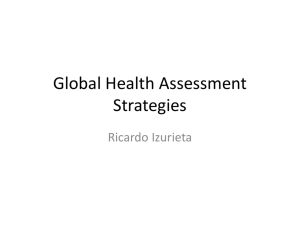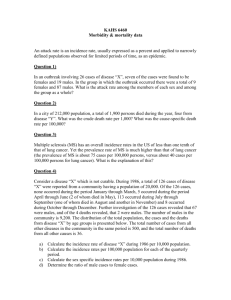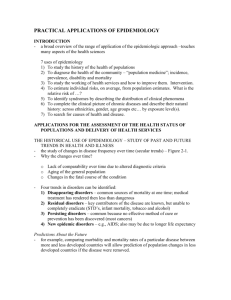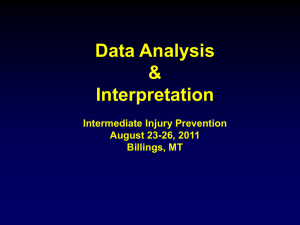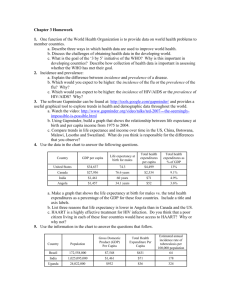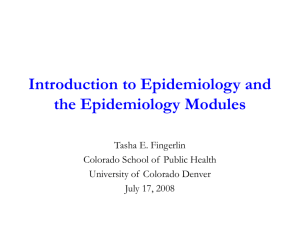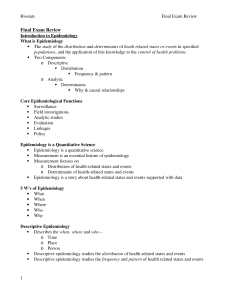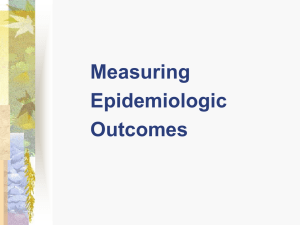The classical definition of Greek origin Epi –upon Domos – the
advertisement
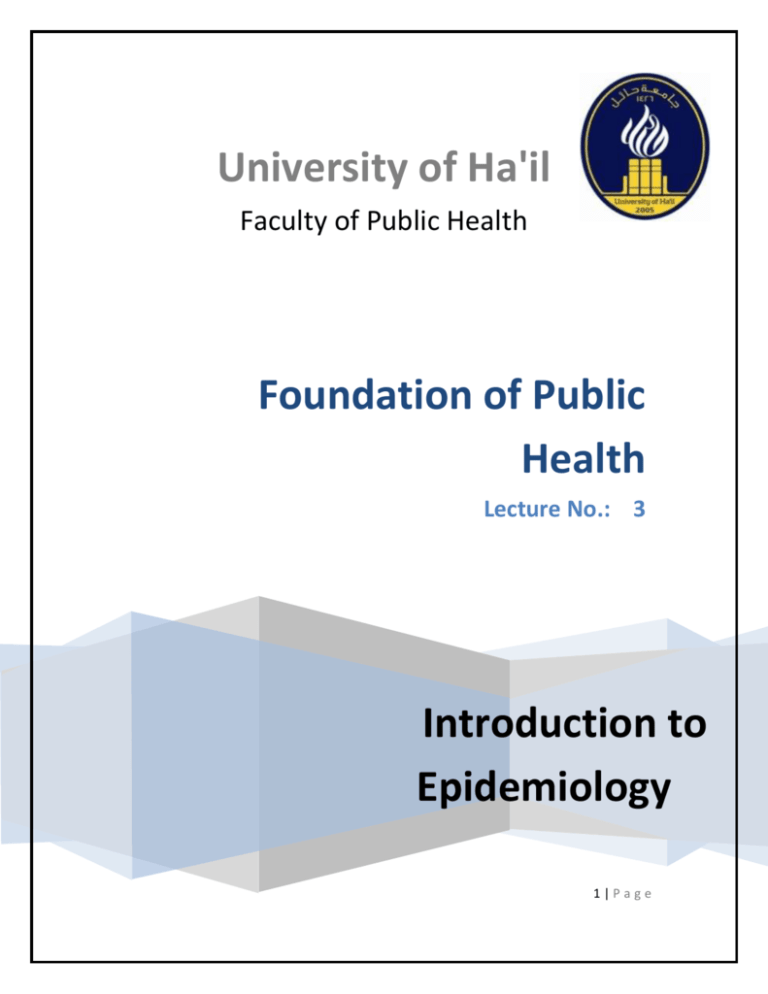
University of Ha'il Faculty of Public Health Foundation of Public Health Lecture No.: 3 Introduction to Epidemiology 1|Page The classical definition of Greek origin Epi –upon Domos – the people Ology – the study of “the study of epidemics” Definition of Epidemiology Study of the distribution and determinants of diseases and injuries in human populations Concerned with frequencies and types of injuries and illness in groups of people Focus is not on the individual Concerned with factors that influence the distribution of illness and injuries Background Relatively new science – emerged in 19th century in strictest terms – study of epidemics Today: Concerned with epidemic disease and all other forms of illness and bodily injury o Cancer, heart disease o HIV/AIDS o Alcoholism, drug addiction o Suicide o Automobile accidents Concerned with HC delivery processes Health services research or healthcare epidemiology Relationship between Clinical Medicine and Epidemiology Focus in medicine is the individual patient Community replaces the individual patient in epidemiology Seven Uses of Epidemiology To study the history of the health of the population To diagnose the health of the community 2|Page To study the working of health services To estimate from the group experience what are individual risks To identify syndromes To complete the clinical picture of chronic disease To search for causes Fundamental Assumptions in Epidemiology Disease doesn’t occur at random Disease has causal and preventive factors Disease is not randomly distributed throughout a population Epidemiology uses systematic approach to study the differences in disease distribution in subgroups Allows for study of causal and preventive factors Components of Epidemiology Measure of disease frequency o Quantification of existence or occurrence of disease Distribution of disease - three questions o Who is getting disease? o Where is disease occurring? o When is disease occurring? Formulation of hypotheses concerning causal and preventive factors Determinants of disease o Hypothesis are tested using epidemiologic studies Progression of Epidemiologic Reasoning 1. Suspicion that a factor may influence occurrence of disease o o Observations in clinical practice Are HC providers seeing unexpected illness patterns in their patients? - Examination of disease patterns Do subpopulations have higher or lower rates? Are disease rates increased in the presence of certain factors? 3|Page - Observations in laboratory research Theoretical speculation - What theories can be generated from existing knowledge of disease prevention and causation models? 2. Formulation of specific hypotheses - Based on suspicions concerning influence of a particular factor on disease occurrence 3. Conduct study - Hypotheses are tested to determine if statistical associations between factors and disease occurrence exist Study population is assembled from individuals with disease or outcome of interest and an appropriate comparison group Data is collected and analyzed 4. Assess validity of association - Does the observed association really exist? - Is the association valid? - Are there alternative explanations for the association? Chance Bias Confounding 5. Make a judgment of whether a cause-effect relation between factors (exposure) exists - What is the magnitude of the association? Are the findings consistent with previous studies (or conflicting)? Are the findings biologically credible? Can underlying biological mechanisms that support the association be identified? Historical Perspective John Graunt – 1662 (Hennekins and Buring 1987) The Nature and Political Observations Made Upon the Bills of Mortality Systematic statistical approach Analyzed births and deaths in London Excess of males born, higher mortality for males Infant mortality is very high Seasonal variation for mortality Importance of routinely collected information for study of human illness William Farr - 1839 Examined mortality and occupation and marital status Identified important issues in epidemiological investigations Use of comparison population, influence of multiple factors on disease 4|Page John Snow (1854) – Father of modern epidemiology Established modern epidemiologic methods Cholera epidemic in London Plotted geographical location of all cases – deaths from cholera Went door to door, collecting information on daily habits Suspected water supply as source of epidemic Broad street pump closed, epidemic stopped Mode of investigation – “shoe leather” Practical application of epidemiology – use epidemiological investigation to impact a health problem Epidemiologist studies: Host characteristics: Biological factors: Age, sex, degree of immunity, other physical attributes that promote resistance or susceptibility Behavioral factors : Habits, culture, lifestyle Social environment Living conditions such as poverty, crowding Norms, values and attitudes Socially prescribed standards of living : Use of food and water, food handling practices Household and personal hygiene Definitions Epidemiologic Triad: Traditional Model of Infectious Disease Causation The epidemiologic triangle recognized three factors in the pathogenesis of disease: 1. Host 2. Agent 3. Environment 5|Page AGENT Agent: must be present for an infection to occur: Microbial agents Characteristics of Infectious disease agents: Infectivity Pathogenicity Virulance Toxigenicity Resistance Antigenicity HOST After exposure: from sub-clinical infection (in apparent) to active case of the disease. End Result: Recovery, disability, disfigurement, death. Ability to fight infections, comprises 2 broad categories: Non-specific defense mechanisms Disease specific defense mechanisms ENVIRONMENT Domain in which the disease-causing agent may exist, survive or originate. Acts as a reservoir or niche that fosters the survival of infectious disease agents. The reservoir may be a part of the physical environment or may reside in animals or insects (vectors) or other human beings (human reservoir – host) External Environment: physical, biologic, social, economic components Means of Transmission – Directly or indirectly from reservoir DIRECT TRANSMISSION: Spread of infection through person to person contact Portals of exit: sites where infectious agents may leave the body (respiratory passages, the alimentary canal, the openings in the genitourinary system, and skin lesions. Also through insect bites, the drawing of blood, surgical procedures and accidents) Portal of entry: respiratory system (influenza, cold), the mouth & digestive system (hepatitis A), mucous membranes or wounds in the skin. 6|Page INDIRECT TRANSMISSION: Through an intermediary source Vehicle: contaminated H2O, infected blood on used hypodermic needles. Fomites: in animated objects: doorknob or clothing. Vectors: animate, living insect or animal that is involved with transmission of the disease agent. Case Episode of disorder, illness, or injury affecting an individual Case of measles Cancer case TB case Food poisoning event Various sources provide case information Interviews or surveys Medical providers Institutions or agencies Incidence Measure of new cases of disease (or other events of interest) that develop in a population during a specified period of time E.g. Annual incidence, five-year incidence Measure of the probability that unaffected persons will develop the disease Used when examining an outbreak of a health problem Prevalence Number of existing cases of disease or other condition o Proportion of individuals in a population with disease or condition at a specific point of time Diabetes prevalence, smoking prevalence o Provides estimate of the probability or risk that one will be affected at a point in time o Provides an idea of how severe a problem may be – measures overall extent o Useful for planning health services (facilities, staff) Epidemic, Endemic and Pandemic Epidemic Any significant increase in the number of persons affected by a disease 7|Page The first occurrence of a new disease Endemic A disease that is established within a population that remain at a fairly stable prevalence Pandemic Widespread, universal disease penetration over a wide geographic area More Terms Morbidity n Mortality Acute disease illnesses, symptoms, impairments deaths diseases that strike and disappear quickly, within a month or so (chicken pox, colds) Chronic disease Birth cohort : Life expectancy: : long term or lifelong diseases, incurable Persons born in a given year Average number of years of life remaining to a person at a particular age Based on mortality rates and personal characteristics (e.g. gender, race) Years of potential life lost Measure of premature mortality Death before age 75 Epidemiologic Measures RATIO Used to compare two quantities ( 1:1.1 ratio of female to male births ) Used to show quantity of disease in a population Cases = Populatio n 8|Page Proportion ◦ A specific type of ratio in which the numerator is included in the denominator, usually presented as a percentage Calculation of proportion: E.g. Males undergoing bypass surgery at Hospital A Total patients undergoing bypass surgery at Hospital A 352 males undergoing bypass surgery 539 total patients undergoing bypass surgery = 65.3% Rate Special form of proportion that includes a specification of time Most commonly used in epidemiology because it most clearly expresses probability or risk of disease or other events in a defined population over a specified period of time 3 major types Crude rates Specific rates (age-specific, infant mortality) Adjusted rates Crude rates Unadjusted, simple ratios Cases in defined period of time x K Population in defined period of time (K denotes units 100’s, 1,000, etc.) E.g. Crude mortality rate: Total deaths in 2003 x 1,000 = death rate Estimated U.S. pop in 2003 9|Page Calculation of rates: Number of events in a specified time period Xk Population at risk of these events in a specified time period (K is used to denote the units of population such as per 1,000 or per 100,000) E.g. 9,981 deaths in Detroit in 2000 951,270 total population in Detroit 2000 = 10.49 per 1,000 = 1049 per 100,000 Specific Rates Capture effects of specific variables or social characteristics Age-specific, gender-specific, gender and race-specific Example – infant mortality – deaths within the 1st year of life Total # of deaths among Persons age less than 1 year x 1,000 Number of live births = infant mortality rate Adjusted or Standardized Rates Allow for comparison of populations with different characteristics Statistically constructed summary rates allow for appropriate comparisons by taking into account differences in populations (age, gender, etc.) Example of use: Population in Arizona is much older than population in Alaska, so it would be inappropriate to compare mortality rates. Standardization allows for meaningful comparisons. 10 | P a g e Calculating prevalence: P= Number of existing cases of disease at a given point in time Total population at risk e.g. P= 2176 pts with asthma 31005 pts = = = .07 7 asthmatics per 100 pts 7% Prevalence calculation: Pediatric Asthma at DNW P= Number of existing cases of disease at a given point in time Total population at risk P= 2159 DNW pts < 19 with asthma encounter 9173 DNW pts < 19 Types of Prevalence Point prevalence: number of cases that exist at a given point in time Lifetime prevalence: proportion of the population that has a history of a given disorder at some point in time Period prevalence: number of cases that exist in a population during a specified period of time 11 | P a g e Cumulative Incidence The proportion of individuals who become diseased during a specified time period. Time period can be a calendar year, 6 months, 3 years, 5 years, etc. Formula for cumulative incidence: CI = Number of new cases of disease during a given time period Total population at risk CI = 70 new cases of breast cancer in a 5 year period 3,000 women at risk = 0.023 = 23 cases per 1,000 women during 5 years Incidence Rate Also known as incidence density Measure of incidence that is able to handle varying observation periods Denominator is sum of person-time at risk Formula for incidence rate or incidence density: ID = Number of new cases of disease during a given time period Total person-time at risk ID = 70 new cases of breast cancer 13,000 women-years of observation = 0.0054 = 5.4 cases / 1,000 women years 12 | P a g e
